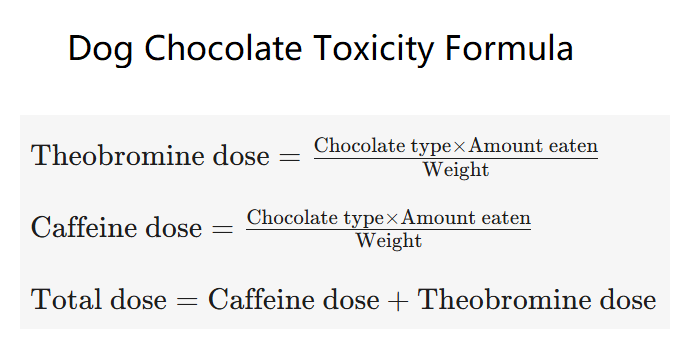 Home
Home
 Back
Back

Chocolate contains substances called methylxanthines (specifically caffeine and theobromine), which are toxic to dogs. The level of toxicity depends on the type of chocolate, the amount consumed, and the size of the dog.
This calculator estimates the potential toxicity based on the dog's weight, the type of chocolate, and the amount ingested. Always consult a veterinarian if your dog has consumed chocolate.
No. No. No. Three times, no. Chocolate contains substances called methylxanthines. They are harmless to humans but deadly dangerous for our beloved pets due to their different metabolism mechanisms.
The group of methylxanthines contains:
The combined amount of these substances allows us to measure the deadliness of a given food, usually given in milligrams per kilogram.
"My dog ate chocolate!" — your sister screamed in terror, holding the door wide open and looking straight into your eyes[…]
Dogs shouldn't eat any chocolate, that's for sure — but is there really a place to panic?
This tool serves as the Dog ate chocolate calculator — if you're looking for the cat version, try our cat chocolate toxicity calculator.
Your results are here — copy them carefully, your vet may need them!
Chocolate can be lethal to dogs. We definitely shouldn't give them even a little bit of it. Pets metabolize food in a different way than humans do.
Theobromine and caffeine are two substances that are deadly to them. It is generally believed that a combined dose of less than 15.01 mg/kg (7.5 mg/lb) shouldn't harm your dog.
This dose is equivalent to:
Try our pet chocolate toxicity calculator to compute the doses for different kinds of chocolates, cakes, desserts, and coffee — specific for your pet's weight! ☕
The first step of calculating toxicity is to know the concentration of the harmful substances in a given food. Our dog chocolate calculator is fully prepared for this task.
If you already have all the data you need, proceed to the calculations:
We used all the equations presented above to create our pet chocolate calculator.
Where:
To evaluate the total toxicity, we need to use the Total dose that we've already calculated:
The mentioned dog, just like any other pet, should avoid eating any chocolate. If the amount devoured by your dog is lower than given in the table, your pet should generally be ok. One piece of chocolate usually weighs 6 grams (0.21 oz).
| Type of Chocolate | Max Amount for a 70 lb (32 kg) Pet |
|---|---|
| White Chocolate | 12.6 kg (27.8 lb) |
| Milk Chocolate | 212 g (0.47 lb) |
| Dark-Sweet Chocolate | 92 g (3.2 oz) |
| 60% Cocoa | 56.8 g (2 oz) |
| 72% Cocoa | 47.4 g (1.67 oz) |
| 86% Cocoa | 39.6 g (1.4 oz) |
Yes. Chocolate contains very dangerous substances for dogs due to their different metabolism mechanisms. The darker the chocolate, the more poisonous it is for dogs. So, you should definitely avoid giving any piece of chocolate to your dog.
Less than 20 g of milk chocolate. The safe dose of methylxanthines is generally believed to be less than 15.01 mg/kg. This value depends on the type of chocolate. If your dog eats 19 g of milk chocolate, the methylxanthines dose will be:
14.31 mg/kg = (14.31/3) mg = 4.77 mg
If you know your dog ate chocolate, you should:
Yes. This is not a risk of toxicity to your dog because it contains a very low level of caffeine and theobromine. Therefore, treatment is not required. However, white chocolate has ingredients that pets should not consume, such as cocoa butter, sugar, and milk, so try not to give white chocolate to your dog.